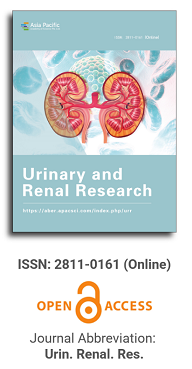
Asia Pacific Academy of Science Pte. Ltd. (APACSCI) specializes in international journal publishing. APACSCI adopts the open access publishing model and provides an important communication bridge for academic groups whose interest fields include engineering, technology, medicine, computer, mathematics, agriculture and forestry, and environment.
Sponge kidney and renal lithiasis
Vol 3, Issue 1, 2022
Download PDF
Abstract
Introduction: Sponge kidney is a renal malformation, of the collecting tubules, usually associated with nephrocalcinosis or distal tubular acidosis. The association with renal lithiasis is observed in 4-20%. Objective: The aim of our study was to describe biochemical risk factors for renal lithiasis in patients with sponge kidney. Material and methods: A retrospective, observational, cutoff study was performed between 2000 and 2017 where 37 patients with sponge kidney and renal lithiasis (26 females and 11 males) aged 37.3 ± 13.2 years were studied. The diagnosis of sponge kidney was made by excretory urogram. Results: Nephrocalcinosis was observed in 95%. The most frequent biochemical diagnosis was idiopathic hypercalciuria, which as the only and associated alteration was observed in 59.4%. Hyperuricosuria was the second diagnosis found in 32.4% (sole and associated) followed by hypocitraturia, hypomagnesuria and persistently acidic pHu. In men it was noteworthy that 46.2% did not present biochemical alteration. Conclusions: In conclusion, the relatively frequent association of sponge kidney and renal lithiasis stands out. Idiopathic hypercalciuria was the most frequent metabolic alteration as a cause of lithogenesis, followed by hyperuricosuria, similar to that described in the literature, although in a smaller proportion. Other alterations, such as hypocitraturia, hypomagnesuria and persistently acidic pHu should also be considered in the study of these patients.
Keywords
References
- Goldfarb DS. Evidence for inheritance of medullary sponge kidney. Kidney Int. 2013;83(2):193-6.
- Fabris A, Anglani F, Lupo A, Gambaro G. Medullary sponge kidney: state of the art. Nephrol Dial Transplant. 2013;28(5):1111-9.
- Higashihara E, Nutahara K, Tago K, Ueno A, Niijima T. Medullary sponge kidney and renal acidification defect. Kidney Int. 1984;25(2):453-9.
- Lahme S, Bichler K-H, Lang F, Feil G, Strohmaier WL, Radjiaipour M. Metabolic Evaluation of patients suffering from medullary sponge kidney. In: Eighth European Symposium on Urolithiasis, edited by Borghi L. Parma: Editoriale Bios, 1999, pp. 599-601.
- Cameron S. Medullary sponge kidney. In: Oxford Textbook of Clinical Nephrology. Edited by Alex M. Davison, et al. 3rd ed. Oxford, New York: Oxford University Press, 2005, pp. 2495-2501.
- Fabris A, Lupo A, Bernich P, Abaterusso C, Marchionna N, Nouvenne A, et al. Long-term treatment with potassium citrate and renal stones in medullary sponge kidney. Clin J Am Soc Nephrol. 2010;5(9):1663-8.
- Fabris A, Bernich P, Abaterusso C, Marchionna N, Canciani C, Nouvenne A, et al. Bone disease in medullary sponge kidney and effect of potassium citrate treatment. Clin J Am Soc Nephrol. 2009;4(12):1974-9.
- Gambaro G, Feltrin GP, Lupo A, Bonfante L, D'Angelo A, Antonello A. Medullary sponge kidney (Lenarduzzi- Cacchi-Ricci disease): a Padua Medical School discovery in the 1930s. Kidney Int. 2006;69(4):663-70.
- Torres VE, Grantham JJ. Cystic diseases of the kidney. In: Brenner & Rector's the Kidney. [Edited by] Maarten W. Taal, et al. 9th ed. Philadelphia, PA: Elsevier, Saunders, 2012, pp. 1655-7.
- Goldman SH, Walker SR, Merigan TC Jr, Gardner KD Jr, Bull JM. Hereditary occurrence of cystic disease of the renal medulla. N Engl J Med. 1966;274(18):984-92.
- Stratta P, Canavese C, Lazzarich E, Fenoglio R, Morellini V, Quaglia M, et al. Medullary sponge kidney. Am J Kidney Dis. 2006;48(6):e87-8.
- McPhail EF, Gettman MT, Patterson DE, Rangel LJ, Krambeck AE. Nephrolithiasis in medullary sponge kidney: evaluation of clinical and metabolic features. Urology. 2012;79(2):277-81.
- Torregrossa R, Anglani F, Fabris A, Gozzini A, Tanini A, Del Prete D, et al. Identification of GDNF gene sequence variations in patients with medullary sponge kidney disease. Clin J Am Soc Nephrol. 2010;5(7):1205-10.
- Sariola H, Saarma M. Novel functions and signalling pathways for GDNF. J Cell Sci. 2003;116(Pt 19):3855-62.
- Fabris A, Lupo A, Ferraro PM, Anglani F, Pei Y, Danza FM, et al. Familial clustering of medullary sponge kidney is autosomal dominant with reduced penetrance and variable expressivity. Kidney Int. 2013;83(2):272-7.
- Zerwekh JE. Bone disease and idiopathic hypercalciuria. Semin Nephrol. 2008;28(2):133-42.
- Cameron S. Medullary sponge kidney. In: Oxford Textbook of Clinical Nephrology. Edited by Alex M. Davison, et al. 3rd ed. Oxford, New York: Oxford University Press, 2005, pp. 2495-2501.
- Yagisawa T, Kobayashi C, Hayashi T, Yoshida A, Toma H. Contributory metabolic factors in the development of nephrolithiasis in patients with medullary sponge kidney. Am J Kidney Dis. 2001;37(6):1140-3.
Supporting Agencies
Copyright (c) 2022 Francisco Rodolfo Spivacow
License URL: http://creativecommons.org/licenses/by-/4.0

This site is licensed under a Creative Commons Attribution 4.0 International License (CC BY 4.0).
.png)
Prof. Wei-Yen Hsu
National Chung Cheng University, Taiwan

